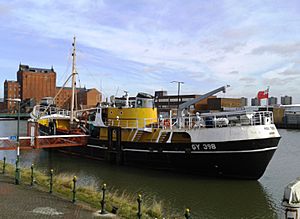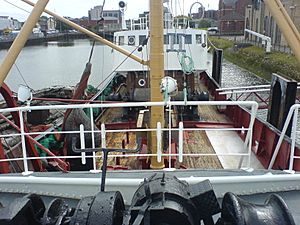Ross Tiger facts for kids
 |
|
Quick facts for kids History |
|
|---|---|
| Name | Ross Tiger |
| Owner | Ross Trawlers Ltd |
| Port of registry | Grimsby, Lincolnshire |
| Builder | Cochrane & Sons, Selby |
| Laid down | 1956, completed and in service February 1957 |
| Identification | IMO number: 5300699 |
| Status | Retired 1992 for preservation as a museum ship in Grimsby's Alexandra Dock as part of the Fishing Heritage Centre |
| General characteristics | |
| Type | Trawler |
| Tonnage | 355 tons |
| Length | 127'6 |
| Beam | 26'6 |
The Ross Tiger is a special kind of fishing trawler called a "side-winder." It was turned into a museum ship in 1992. Today, you can find her in Alexandra Dock in her home port of Grimsby. She is a main attraction at the National Fishing Heritage Centre.
The Ross Tiger is important because she is Grimsby's last traditional side-winder trawler. These ships were once a huge part of the world's biggest fishing fleet. She is also listed on the National Register of Historic Vessels.
Contents
Grimsby's Fishing Story
The Ross Tiger, known as GY398, helps us remember the amazing history of Grimsby Port. Grimsby is now a busy place for handling vehicles. But it will always be famous for its incredible fishing past.
Grimsby's docks were once the best in the country. The town was known for its huge fishing fleet. Fishing in Grimsby goes back to its founder, a Danish fisherman named Grim. Trawlers from Grimsby were always seen on the River Humber. This was one of the busiest waterways in Britain.
Trawlers in Wartime
During World War II, Grimsby became Britain's largest base for minesweepers. Trawlers and motor minesweepers helped clear over 34,000 mines from the North Sea. Brave sailors used these fishing boats to find mines and hunt submarines.
After the war, the fishing fleet grew a lot. People needed more fish. Grimsby became the largest fishing port in the world. The Ross Tiger (GY 398) was built to help meet this demand.
How Trawlers Changed
Grimsby saw many changes in fishing trawlers. They went from early wooden sailing ships to powerful steam vessels. Steam ships could travel much further north. New steel steam trawlers were designed to handle rough seas.
Later, ships got a "whaleback" at the front. This helped protect the deck where fish were handled. Powerful diesel engines replaced steam engines. The Ross Tiger is an example of the final stage of these side-winder trawlers.
She was built in the 1950s, just before "stern trawlers" became popular. Stern trawlers changed how these ships looked forever. The Ross Tiger still has the classic brass and woodwork from older trawlers. This gives her a special historic feel.
The Ross Tiger's Journey
The Ross Tiger was the first of twelve new trawlers for Ross Trawlers Ltd. She joined the "middle water" fleet. These trawlers took their crews on dangerous trips. Fishing was known as "the most dangerous job in the United Kingdom."
They searched the ocean floor for deep-sea fish like cod and haddock. Haddock was a favorite in Grimsby. Fish from Grimsby was sent all over the country by train. It even went to the famous Billingsgate Fish Market in London.
The Cod Wars and Beyond
The Cod Wars in the 1970s ended the fishing careers for many Grimsby trawlers. Some were saved and used as standby vessels for offshore oil rigs. The Ross Tiger was one of these lucky ships. She changed owners in 1985.
But these older ships soon became too old for that job. The Ross Tiger was again facing being scrapped. Luckily, she was bought by a museum trust. She became the main attraction at her hometown's Fishing Heritage Centre. She was brought back to her original fishing glory.
A newspaper article in 1992 said the Ross Tiger would be a "fitting monument" to the people who sailed from Grimsby. Grimsby was once the world's top fishing port. Visitors can take guided tours of the ship. They learn about the unique spaces and how the equipment was used.
Most of the ship's original parts are still there. This includes her Ruston and Hornsby diesel engines. Her wood paneling, cabins, kitchen (galley), mess hall, and wheelhouse are also original. Even the comfortable skipper's room has its old lampshades.
The Ross Tiger has had a lot of work done on her outside. She is still in good shape. But she needs more funding for future repairs. This includes work on her hull. Without this, the ship could get worse.
The 'Cat Class' Trawlers
The Ross Tiger was the first of twelve new trawlers for Ross Trawlers Ltd. These ships were part of the "middle water" fleet. They worked alongside the company's larger "deep water" fleet.
The Ross Tiger and her sister ships were called the "Cat Class" or "Cat Boats." Each was named after a type of cat. However, Ross Jackal and Ross Zebra were also in this group. A local school probably helped name the ships. This shows how the company involved the town's young people. They even gave school tours of the trawlers.
Where They Fished
As a middle water trawler, Ross Tiger would fish in the North Sea, around the Faroe Islands, and along the Norwegian coast. She could also travel further north. The larger "deep water" ships went to the dangerous Arctic oceans. This included places like Bear Island and Greenland. The Ross Revenge, famous as the radio ship Radio Caroline, was a deep water trawler. She still exists today.
Ross Trawlers also had smaller ships for waters closer to home. These were called the "Bird Class" or "Bird Boats." They were named after birds, like Ross Falcon and Ross Mallard.
Changes to the 'Cat Class'
Since Ross Tiger was the first, later Cat Class ships had small changes. For example, their bridge tops were a bit longer. This allowed for bigger side-light screens. They also added bobbin derricks to help with fishing. Most ships built after 1958 had a flat back (transom). But Ross Jackal in 1960 kept the rounded back like Ross Tiger. Despite these small differences, the ships in this class were mostly the same.
Today, Grimsby, once the world's biggest fishing port, has only a few small fishing boats. There is no deep water fleet anymore. The way Ross Tiger fished was very hard. It involved heavy equipment, open decks, and long hours. Fishermen had to clean fish by hand on deck. Modern deep-sea trawlers are much different and safer.
The Ross Tiger is the only reminder in Grimsby of this traditional way of fishing. She shows what people in this area did for many years.
Statistics
- Builders: Cochrane & Sons, Selby, Yard No 1416.
- Delivery: Grimsby, February 1957.
- Gross Tonnage: 355 tons.
- Nett Tonnage: 127 tons.
- Length: 127.6 ft.
- Beam: 26.5 ft.
- Depth: 13 ft.
- Engines: 7 Cylinder, Diesel, made in Lincoln, Lincolnshire by Ruston & Hornsby.
The 'Cat Boats'
- Ross Tiger - February 1957
- Ross Leopard - October 1957 (thought to have been taken apart in Belgium)
- Ross Jaguar - December 1957 (turned into a tall-ship named Jaguar)
- Ross Panther - April 1958
- Ross Cougar - April 1958
- Ross Cheetah - November 1959
- Ross Lynx - February 1960
- Ross Jackal - April 1960
- Ross Puma - August 1960 (wrecked in 1968, but all crew were saved)
- Ross Genet - October 1960
- Ross Civet - October 1960
- Ross Zebra - November 1960.
Images for kids
-
Ross Tiger skipper Alf Hodson (left), with Mate L Torrington. Mr Hodson later became a respected guide at the Grimsby Fishing Heritage Centre.







